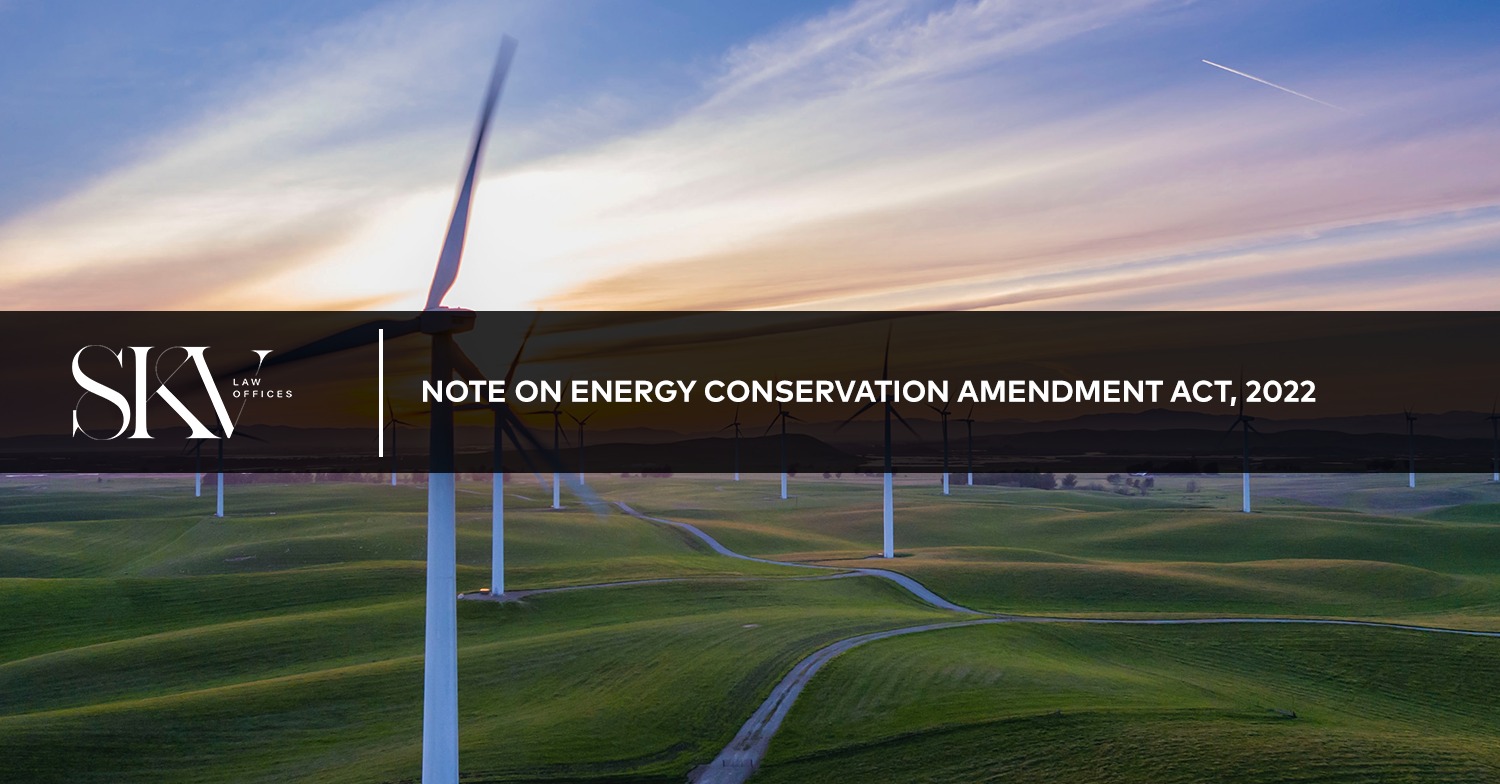Note on Energy Conservation Amendment Act, 2022
by Vedant Choudhary & Kanika Chugh
16.02.2023
The purpose of the Energy Conservation Amendment Act, 2022 is to offer a timely and forward-thinking effort for fulfilling the nation’s goals under the Paris Agreement to combat climate change, the intention behind this amendment was that India would achieve 50% of its installed energy capacity from non-fossil fuel sources and reduce its economy’s carbon intensity by 45% from 2005 levels by 2030. Given that energy sources account for a significant amount of India’s greenhouse gas emissions, this amendment is anticipated to assure the decarbonization of the Indian economy through increased usage of renewable energy sources. The amended Act comes a year after Prime Minister Modi announced India’s 2070 Net Zero target (removing as much carbon as has been pumped into the atmosphere due to human induced activities) at Glasgow during COP26.
The Energy Conservation Act, 2001, was amended with the Energy Conservation (Amendment) Act, 2022. The amended Act with all its provisions came into force on January 1, 2023.
The following are some of the significant changes under this amendment:
- Mandatory non-fossil fuel consumption by specific entities
According to the amendment, “designated users” of energy must get a predetermined percentage of their energy needs from non-fossil sources. Additionally, the government may define a different consumption proportion for various non-fossil sources for various specified users. Currently, designated users include certain categories of industries, transportation, and commercial structures.
- Trading scheme for carbon credit certificates
The amendment gives the Union Government the authority to launch a carbon trading programme to promote the economy’s reduction of carbon emissions. Although the amendment does not define “carbon credit,” it is commonly understood to be a credit given to a business for decreasing or eliminating a certain quantity of carbon emissions from its activities. Under this programme, the Government of India or a designated agency would issue carbon credit certificates to registered entities, which they are free to exchange with other registered companies. These certificates are also available for voluntary purchase by other people. It is anticipated that the issuance of these certificates and their exchange on the open market will encourage organisations to invest in technologies or environmentally friendly solutions to lower their overall energy consumption and, consequently, their carbon emissions.
- Code for energy conservation in large structures
The building and construction industry accounts for about 24% of India’s energy needs. As a result, it’s critical to promote energy efficiency and lower energy usage in this industry. With this goal in mind, the amendment calls for the application of a “energy conservation and sustainable building code” to all commercial, office, and residential structures that satisfy certain standards. The lower energy usage threshold outlined in the Act may also be determined by state governments for their individual jurisdictions. They can also modify this code to fit the regional and local climatic conditions in conjunction with the Bureau of Energy Efficiency.
- Vehicle energy consumption standards
The main statute enables the government to prescribe energy efficiency requirements for machinery and appliances. For electronic appliances, the Bureau of Energy Efficiency has announced such guidelines. With this modification, the government is now able to define similar criteria for boats and ships as well as motor vehicles covered under the Motor Vehicles Act of 1988. This aims to reduce energy use and emissions from the transportation industry.
- Setting up a special fund for State Energy Conservation Fund.
In order to promote energy efficiency and conservation measures, the amendment mandates that State Governments establish energy conservation funds. The Union Government’s loans and grants as well as all fees collected by the State Government in accordance with the main statute will be contributed to this fund, among other things.
- Penalty
The amended Act, has factored in penalties and enhanced existing penalties for violations under the Act:
- enhances penalty for equipment and appliances that fail to conform with the energy consumption standards specified by the Central Government and for equipment and appliances that do not contain particulars as specified by the Regulations,
- introduces penalty for vessels and vehicles,
- vehicle manufacturers in violation of fuel consumption norms,
- failure to comply with directions issued for minimum share of consumption of non-fossil sources by designated consumers,
- prohibits the use of deceptive names that resemble the name of the Bureau, used to deceive or likely to deceive the public,
- failure to provide information to the Bureau, as required, has been made punishable,
- new clause to Section 28 under which the Adjudicating Authority while deciding the quantum of punishment under Section 26 will now also pay due regard to the loss caused to a consumer in addition to the two factors under the Act i.e. (a) the amount of disproportionate gain or unfair advantage, wherever quantifiable, made as a result of the default and (b) the repetitive nature of the default.
- Governing council of BEE:
The Act provides for the setting up of the Bureau of Energy Efficiency (BEE). Prior to the Amendment, the general superintendence, direction, and management of the affairs of the Bureau vested with the Governing Council, which had 20-26 members. The Amendment Act amends this to provide that the Governing Council shall comprise of 31-37 members.


